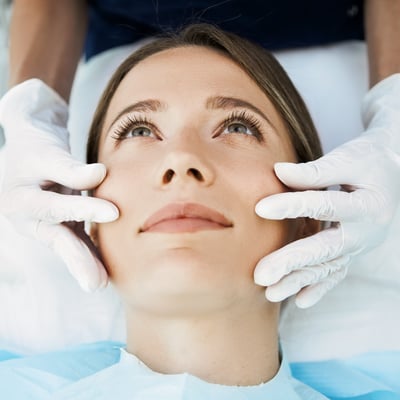
Are you willing to do just about anything to get rid of pimples—even if it means giving up the foods you love? You’re not alone. Many people who battle acne have tried all of the recommended at-home treatments, like washing their face twice daily with a gentle cleanser and using oil-free cosmetics, all to no avail…and so it’s natural to wonder if examining the cause of acne from the inside might help.
The truth is that some things you put into your body might make acne worse, but not all acne-triggering foods affect everyone the same. Having an idea of what to cut back on might help you experiment with your own diet and ultimately achieve better skin.
What causes acne?
Acne is often an annoying side-effect of puberty, menstruation, or pregnancy, caused by an influx of hormones which leads to excess sebum (or oil) production. When that oil mixes with dead skin cells and dirt, pores become clogged and inflamed, and pimples pop up.
Acne can also be attributed to genetics. If your parents battled a ton of zits, you are likely to have them as well. Some medications can exacerbate acne, too, such as steroids and certain antibiotics.
Associations between diet and acne: Are some foods shown to make acne worse?
There is some research that shows certain foods can produce pimples. Scientists have performed studies that found those who had a lot of acne tended to eat the same types of foods—but there is not enough evidence to prove that consuming these foods actually causes acne. Still, the results of these studies are strong enough that dermatologists often recommend patients eliminate these things from their diet to see if it can help skin clear up.
Milk
Since 2005, researchers have found that those who drank milk—or more specifically teenagers who drank at least two glasses per day—were more likely to have severe acne. Milk comes from pregnant or nursing cows, so when those hormones get transferred via the creamy beverage, excess sebum is likely to form and clog pores in the person who drinks it.
Results confirming an association between milk and acne have remained consistent for the past 20 years, but the American Academy of Dermatology Association (AAD) says no studies have found that all products made from milk, such as yogurt or cheese, lead to more breakouts. The takeaway? If you’re dealing with acne, it might be worth eliminating milk from your diet to see if it helps.
Sugary foods and beverages
Foods with a high-glycemic index, or those that turn to sugar in the bloodstream, are commonly seen in the diet of patients with acne. This could be because when our bodies make insulin to bring down blood sugar, it affects the hormones that increase oil production in your skin. Blood sugar spikes also cause inflammation in the body, and inflammation causes us to make more sebum (oil) too.
By avoiding white bread, pasta, white rice, and cake, which all break down directly into sugar; as well as sugary beverages that cause blood sugar to spike, it’s possible you might enjoy a more clear complexion.
Whey protein
More and more of today’s young athletes are ingesting protein bars and supplement powders that contain whey protein. The Dermatology Education Foundation (DEF) says they are seeing a correlation between this type of diet and acne, perhaps because whey is one of the main protein isolates in milk. Studies also show that whey protein raises levels of insulin-like growth factor 1 (IGF-1) that can increase sebum (oil) production.
While there isn’t yet an overwhelming amount of evidence that whey protein makes acne worse, acne sufferers might benefit from removing this type of supplement from their diet to see if it helps.
Busting myths: Foods that don’t cause acne
You may have heard that these foods are common causes of acne. But, surprisingly, there’s no research to prove it.
Fried foods
Overindulging in greasy foods is never a good thing for our health, but eating foods that are fried doesn’t necessarily make acne worse. That’s because the fat in what we eat doesn’t produce the oil that develops in our skin. If you spend a lot of time frying foods, though, try to avoid getting the grease on your hands and then touching your face. Oil that gets on your skin can clog pores.
Chocolate
You probably remember being told as a teen that eating chocolate causes zits, but there is little proof of that. Some scientists have attributed the myth to the combination of sugar and milk in chocolate, so if you struggle with acne and want to see if cutting back on the sweet treat helps, go for it. Or: Switch to dark chocolate, since it has less sugar and is healthier for you anyway.
Are there foods that improve acne?
The same diet that doctors recommend for overall health has been found to help prevent or clear up acne. Make sure to integrate these into your diet to improve your chances of a better complexion.
Fiber
Just as high-glycemic foods make acne worse by spiking blood sugar, low-glycemic foods help control blood sugar — which can minimize zits. Try eating a high-fiber diet containing foods like brown rice, oats, beans, carrots, and apples.
Fruits and veggies
Because acne is often caused by inflammation, foods that combat inflammation are great for combatting acne. A diet rich in vitamins and antioxidants is known for preventing inflammation, so opt for bell peppers and citrus fruits which are full of vitamin C, leafy greens like spinach and kale for vitamin E, and blueberries and raspberries which have lots of antioxidants.
Water
Drinking at least 10 glasses of water every day helps balance the water and oil content in our skin, which prevents excess sebum from clogging pores. Water also helps flush toxins from the body, such as bacteria that causes acne. Swap out milk and sugary drinks for a few more glasses of water, and you should see an improvement in your skin.
The best advice to reduce acne with diet changes? Pay attention to triggers.
While more research is needed to know whether certain foods actually cause acne, it may help to keep a log of what foods tend to break you out. When lots of zits pop up, jot down what you had eaten the day before. Now try eliminating that food from your diet for a week or so and see if your skin clears up. It may take some experimenting, but you might see a pattern that will help determine what to steer clear of.
When to see a dermatologist for acne treatment
If you are washing your face twice a day to remove oil, have used salicylic acid treatments with no success, and have tried eliminating foods known to make acne worse but still have lots of blemishes, it may be time to see a dermatologist. There are several acne treatments a dermatologist may recommend, such as:
- Prescription acne treatments. Often more effective than over the counter options, your doctor may prescribe isotretinoin to reduce the production of the natural oil (sebum).
- Oral antibiotics. This can eliminate the bacteria that’s causing inflammation in your pores.
- Birth control pills. Since hormones play a role in the development of acne, your doctor may prescribe birth control pills to help clear your complexion.
- A deep facial. In this safe procedure, a provider steams the face to open pores, then extracts the dirt and debris that’s clogging them.
- Laser acne treatment. In some patients, sebaceous glands are overactive, which makes acne hard to treat with topical or oral solutions. Laser acne treatment works by penetrating deep into the skin’s cellular layer and countering overactive glands, promoting new skin cell growth. Laser acne treatment also helps to shrink skin pores to make pimples less prominent.
A good dermatologist will listen to your skin concerns, discuss which acne treatments you’ve already tried, and come up with a solution that will make you happier with your complexion. When you’re ready to see positive results, contact a Forefront location near you.





